
The University of Louisville (UofL) is a public research university in Louisville, Kentucky, United States. It is part of the Kentucky state university system. Chartered in 1798 as the Jefferson Seminary, it became in the 19th century one of the first city-funded public colleges in the United States. The university is mandated by the Kentucky General Assembly to be a "Preeminent Metropolitan Research University".

Old Louisville is a historic district and neighborhood in central Louisville, Kentucky, United States. It is the third largest such district in the United States, and the largest preservation district featuring almost entirely Victorian architecture. It is also unique in that a majority of its structures are made of brick, and the neighborhood contains the highest concentration of residential homes with stained glass windows in the U.S. Many of the buildings are in the Victorian era styles of Romanesque Revival, Queen Anne, or Italianate, and many blocks have had few or no buildings razed. There are also several 20th-century buildings from 15 to 20 stories.

Transylvania University is a private university in Lexington, Kentucky, United States. It was founded in 1780 and is the oldest university in Kentucky. It offers 46 major programs, as well as dual-degree engineering programs, and is accredited by the Southern Association of Colleges and Schools. Its medical program has graduated 8,000 physicians since 1859.

The Speed Art Museum, originally known as the J.B. Speed Memorial Museum, now colloquially referred to as the Speed by locals, is the oldest and largest art museum in Kentucky. It was established in 1927 in Louisville, Kentucky, on Third Street next to the University of Louisville Belknap campus. It receives around 180,000 visits annually.
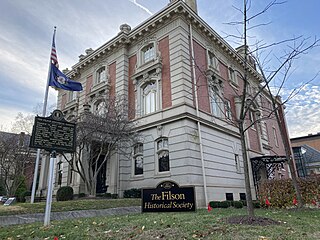
The Filson Historical Society, previously known as The Filson Club, is a privately supported historical society located in the Old Louisville neighborhood of Louisville, Kentucky. Founded in 1884, the Filson is an organization dedicated to continuing adult education through a quarterly peer-reviewed academic journal, Ohio Valley History, a quarterly magazine, The Filson, weekly lectures, historical tours, and exhibits.
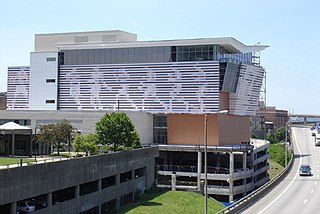
The Muhammad Ali Center is a non-profit museum and cultural center dedicated to boxer Muhammad Ali in Louisville, Kentucky. Ali, a native of Louisville, and his wife Lonnie Ali founded the museum in 2005.
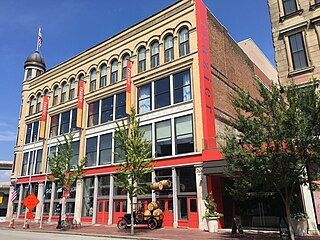
The Frazier History Museum, previously known as the Frazier Historical Arms Museum and the Frazier International History Museum, is a Kentucky history museum located on Museum Row in the West Main District of downtown Louisville, Kentucky.

Downtown Louisville is the largest central business district in the Commonwealth of Kentucky and the urban hub of the Louisville, Kentucky Metropolitan Area. Its boundaries are the Ohio River to the north, Hancock Street to the east, York and Jacob Streets to the south, and 9th Street to the west. As of 2015, the population of downtown Louisville was 4,700, although this does not include directly surrounding areas such as Old Louisville, Butchertown, NuLu, and Phoenix Hill.
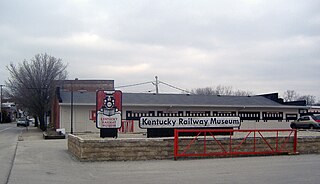
The Kentucky Railway Museum, now located in New Haven, Kentucky, United States, is a non-profit railroad museum dedicated to educating the public regarding the history and heritage of Kentucky's railroads and the people who built them. Originally created in 1954 in Louisville, Kentucky, the museum is at its third location, in extreme southern Nelson County. It is one of the oldest railroad stations in the United States.

Falls of the Ohio State Park is a state park in the U.S. state of Indiana. It is located on the banks of the Ohio River at Clarksville, Indiana, across from Louisville, Kentucky. The park is part of the Falls of the Ohio National Wildlife Conservation Area. The exposed fossil beds of the Jeffersonville Limestone dated from the Devonian period are the main feature of the park, attracting about 160,000 visitors annually. The Falls was the site where Lewis and Clark met for the Lewis and Clark Expedition at George Rogers Clark's cabin.
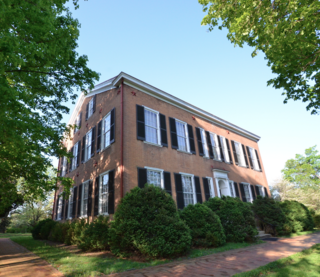
My Old Kentucky Home State Park is a state park located in Bardstown, Kentucky, United States. The park's centerpiece is Federal Hill, a former plantation home owned by United States Senator John Rowan in 1795. During the Rowan family's occupation, the mansion became a meeting place for local politicians and hosted several visiting dignitaries.
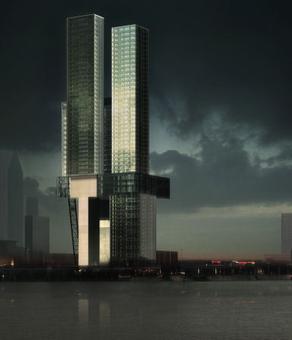
Louisville Museum Plaza was a 62-story skyscraper that was planned for Louisville, Kentucky, United States. By August 1, 2011, despite the expenditure of public funds on its behalf, its developers had officially announced that they were abandoning plans to build it. The 703-foot (214 m) tall skyscraper was projected to cost $490 million and contain a 1-acre (0.40 ha) public plaza and park, condominiums, lofts, a hotel, retail shops and a museum. If built, it would have replaced the AEGON Center as the tallest building in Kentucky. The avant-garde design of the skyscraper was chosen by New York City REX architect Joshua Prince-Ramus. A groundbreaking ceremony was held on October 25, 2007, and construction at that time was expected to be complete by 2010. Delays disrupted the project. Prior to announcing that the project had been abandoned, Craig Greenberg, one of the project's four developers, had stated that he was "hopeful that construction will start this year [2010]" and that he also expected the project to be completed by late 2012.

KMAC Contemporary Art Museum is an American art museum that "connects people to Art and Creative Practice". The museum is a 501c3 organization located in the West Main District of downtown Louisville, Kentucky.

Oxmoor Center is a shopping mall in Louisville, Kentucky. Opening in 1971, its anchor stores are Macy's, Von Maur, H&M, the Apple Store and Dick's Sporting Goods, along with a Topgolf location. The mall is owned by Brookfield Properties and features approximately 960,000 square feet (89,000 m2) of retail space.
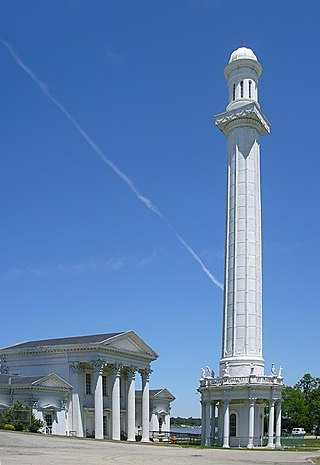
The Louisville Water Tower, located east of downtown Louisville, Kentucky, near the riverfront, is the oldest ornamental water tower in the world, having been built before the more famous Chicago Water Tower. Both the actual water tower and its pumping station are a designated National Historic Landmark for their architecture. As with the Fairmount Water Works of Philadelphia, the industrial nature of its pumping station was disguised in the form of a Roman temple complex.

Louisville, Kentucky is home to numerous structures that are noteworthy due to their architectural characteristics or historic associations, the most noteworthy being the Old Louisville neighborhood, the third largest historic preservation district in the United States. The city also boasts the postmodern Humana Building and an expanding Waterfront Park which has served to remove the former industrial appearance of the riverfront.

The East Market District, colloquially referred to as NuLu, is an unofficial district of Louisville, Kentucky, situated along Market Street between downtown to the west, Butchertown to the north, Phoenix Hill to the south, and Irish Hill to the east. The area is home to schools, churches, large and small businesses and some of the city's oldest homes and businesses. A destination since Louisville's founding, Market Street has played host to a variety of businesses throughout the city's history that have drawn Louisvillians for generations to its addresses.
Louisville WaterWorks Museum opened in the west wing of a renovated and restored interior of Pumping Station No. 1 on Zorn Avenue at 3005 River Road in Louisville, Kentucky overlooking the Ohio River. The building was constructed from 1858 until 1860 as part of Louisville's original water works. It was listed as a National Historic Landmark in 1971.


















